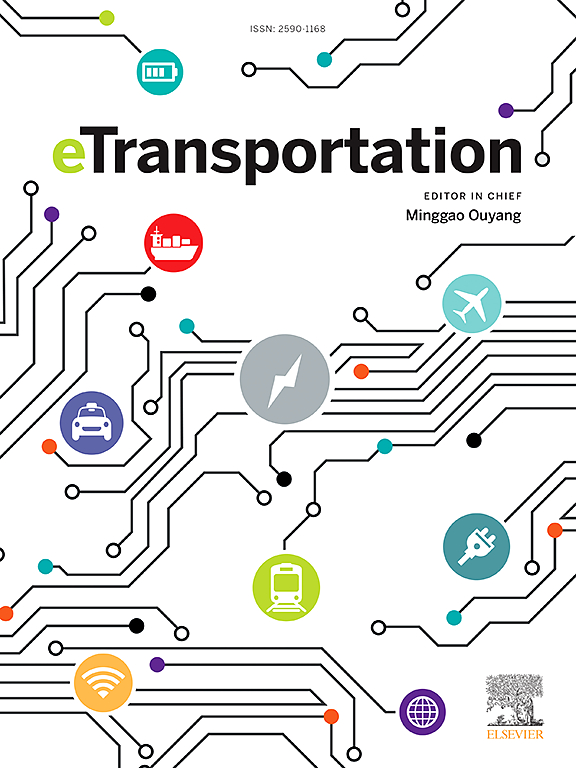大型锂离子电池静态浸没冷却的基本见解:热行为,传热机制和多变量分析
IF 17
1区 工程技术
Q1 ENERGY & FUELS
引用次数: 0
摘要
浸没式冷却已经成为锂离子电池(lib)的一种很有前途的热管理解决方案,与传统方法相比,它提供了更好的散热。然而,大多数现有研究主要集中在小型、低功率电池上,对大型电池的静态浸入式冷却(SIC)的理解存在重大差距。在这项研究中,开发了一个专门的实验平台,系统地研究了冷却方法、浸泡高度、电池放置、环境温度和介电流体类型(变压器油、硅油和氟化液体)的热控制性能。结果表明,与自然空气对流相比,将LIB完全浸入变压器油中可使电池最高温度降低30 - 35%,同时保持45 - 60%的散热率。在高放电倍率(5℃)下,电池温度可有效保持在60℃以下的安全阈值。此外,还分析了流体中的自然对流模式和换热特性。研究发现,当电池处于直立状态时,流体自然对流会增大电池的温差,而当电池处于倒置状态时,温度均匀性会得到改善。此外,在所测试的介质中,氟化液体表现出优异的性能,由于其高热容量和低粘度,散热率达到54.13%。这项研究为SIC机理提供了基本的见解,推进了高效浸入式热管理技术的设计,用于电动汽车和电网规模的储能系统。本文章由计算机程序翻译,如有差异,请以英文原文为准。

Fundamental insights into static immersion cooling of large-scale lithium-ion Batteries: Thermal behavior, heat transfer mechanisms, and multivariable analysis
Immersion cooling has emerged as a promising thermal management solution for lithium-ion batteries (LIBs), offering superior heat dissipation compared to conventional methods. However, most existing research predominantly focused on small-scale, low-power batteries, leaving a critical gap in understanding static immersion cooling (SIC) for large-scale batteries. In this study, a dedicated experimental platform was developed to systematically investigate the thermal control performance of cooling methods, immersion heights, battery placements, ambient temperatures, and dielectric fluid types (transformer oil, silicone oil, and fluorinated liquids). The results indicate that fully immersing the LIB in transformer oil reduces the battery maximum temperature by 30–35 % compared to natural air convection, while maintaining heat dissipation rate of 45–60 %. Under high discharge rates (5 C), the battery temperature can be effectively kept below the 60 °C safety threshold. Furthermore, the natural convection patterns in the fluid and heat transfer characteristics were analyzed. It is found that fluid natural convection may increase the temperature difference when the battery is immersed upright, whereas an inverted configuration could improve temperature uniformity. Besides, among the tested dielectric fluids, fluorinated liquid exhibits superior performance, achieving a heat dissipation rate of 54.13 %, attributed to its high heat capacity and low viscosity. This research provides fundamental insights into SIC mechanisms, advancing the design of efficient immersion thermal management technology for applications in electric vehicles and grid-scale energy storage systems.
求助全文
通过发布文献求助,成功后即可免费获取论文全文。
去求助
来源期刊

Etransportation
Engineering-Automotive Engineering
CiteScore
19.80
自引率
12.60%
发文量
57
审稿时长
39 days
期刊介绍:
eTransportation is a scholarly journal that aims to advance knowledge in the field of electric transportation. It focuses on all modes of transportation that utilize electricity as their primary source of energy, including electric vehicles, trains, ships, and aircraft. The journal covers all stages of research, development, and testing of new technologies, systems, and devices related to electrical transportation.
The journal welcomes the use of simulation and analysis tools at the system, transport, or device level. Its primary emphasis is on the study of the electrical and electronic aspects of transportation systems. However, it also considers research on mechanical parts or subsystems of vehicles if there is a clear interaction with electrical or electronic equipment.
Please note that this journal excludes other aspects such as sociological, political, regulatory, or environmental factors from its scope.
 求助内容:
求助内容: 应助结果提醒方式:
应助结果提醒方式:


